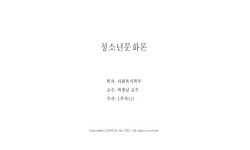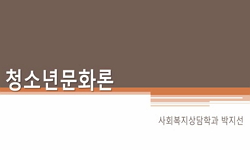This study focuses on the Alternative Culture’s magazine project that attempted to enlighten Korean society in the reverse direction by capturing the voices of youth in the 1990s when they emerged as consumers and producers of culture. Alternative C...
http://chineseinput.net/에서 pinyin(병음)방식으로 중국어를 변환할 수 있습니다.
변환된 중국어를 복사하여 사용하시면 됩니다.
- 中文 을 입력하시려면 zhongwen을 입력하시고 space를누르시면됩니다.
- 北京 을 입력하시려면 beijing을 입력하시고 space를 누르시면 됩니다.

‘청소년 문화’ 읽기의 윤리와 그 딜레마-1990년대 『또 하나의 문화』에 나타난 ‘청소년의 자유’ 담론과 청소년의 글쓰기- = Ethics and Dilemma of Reading ‘Youth Culture’-The discourse of “Youth Freedom” and youth writing in Alternative Culture in the 1990s-
한글로보기https://www.riss.kr/link?id=A108901207
- 저자
- 발행기관
- 학술지명
- 권호사항
-
발행연도
2023
-
작성언어
-
-
주제어
또 하나의 문화 ; 청소년 문화 ; 탈학교 청소년 ; 사이버 키드 ; 오빠 부대 ; 혼종성 ; Alternative Culture ; youth culture ; out-of-school teenagers ; cyberkids ; Oppa’s unit ; and hybridity
-
KDC
900
-
등재정보
KCI등재
-
자료형태
학술저널
-
수록면
309-341(33쪽)
- 제공처
-
0
상세조회 -
0
다운로드
부가정보
다국어 초록 (Multilingual Abstract)
This study focuses on the Alternative Culture’s magazine project that attempted to enlighten Korean society in the reverse direction by capturing the voices of youth in the 1990s when they emerged as consumers and producers of culture. Alternative Culture still adhered to the concept of culture as a practical ground for forming alternative subjects in the 1990s, and employed a strategy to urgently raise youth issues amid rhetoric of crisis that the cultural logic of post-industrial society was being brought to the fore. Issue 13, New Youth Stories 1(May 1997) and Issue 14, New Youth Stories 2(December 1997), were attempts to read youth culture stemming from such awareness of the crisis. In Chapter 2, this study focused on the fact that Alternative Culture did not use the existing method of enlightening youth, but constituted a reverse enlightenment that enlightened adults through reading ‘youth culture’. In the writing that attempted to speak to the youth as an adult who was not a party, the attitude was to listen to the youth’s voice as the voice of a subordinate subject, and to analyze and interpret the youth’s voice and subculture for the decolonization of Korean society. It can be seen that the eyes looking at the required text appear simultaneously. In Chapter 3, this study focused on how the voices of those who were considered ‘bad’ youth in the 1990s appeared in the pages of Another Culture’s magazine. Called out-of-school teenagers, cyberkids, and Oppa’s unit, they breathed the “cyberspace” that emerged in the 1990s and the “hybridity” of pop culture, dismantling hierarchical differentials such as adults/children, real world/virtual world, high culture/low culture, and underground/popularity. The youth’s claim for freedom and liberation did not stop at just asserting their ‘freedom’ and ‘liberation’, as they were approaching cultural democracy by dismantling various hierarchical dichotomies. It is clear that the magazine project of Alternative Culture contributed to the emergence of youth voices with a new ‘status’. However, its limitations can also be found in the fact that the enlightened desires and voices of adults who demanded another sound ‘citizenship’ partially existed.
동일학술지(권/호) 다른 논문
-
- 인하대학교 한국학연구소
- 와타나베나오키
- 2023
- KCI등재
-
- 인하대학교 한국학연구소
- 오선화 ( Wu Xianhua )
- 2023
- KCI등재
-
- 인하대학교 한국학연구소
- 이승희 ( Lee Seunghee )
- 2023
- KCI등재
-
- 인하대학교 한국학연구소
- 고재봉 ( Ko Jaebong )
- 2023
- KCI등재




 KISS
KISS






